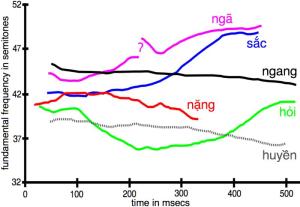Absolute pitch is considered a rare endowment, but its provenance is unclear. A series of experiments with Mandarin, English, and Vietnamese speakers and a consultation of writings on critical periods in speech development and the neurological underpinnings of lexical tone suggests that absolute pitch originally evolved as a feature of speech analogous to other features—such as vowel quality—and that speakers of tone languages naturally acquire this feature during the critical childhood period for speech acquisition.
It follows that the potential for acquiring absolute pitch may be universally present at birth; its realization could depend on enabling the child to associate pitches with verbal labels during the critical period for speech acquisition.
This according to “Absolute pitch, speech, and tone language: Some experiments and a proposed framework” by Diana Deutsch, Trevor Henthorn, and Mark Dolson (Music Perception XXI/3 [Spring 2004] pp. 339–56).
Above, a visualization of Vietnamese speech tones from “Tones and voice quality in modern northern Vietnamese: Instrumental case studies” by Nguyễn Văn Lợi and Jerold A. Edmondson (Mon-Khmer Studies XXVII, pp. 1–18).
Related article: Pitch perception B.C.E.



